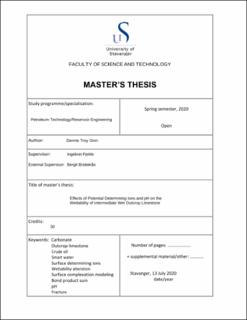| dc.contributor.advisor | Fjelde, Ingebret | |
| dc.contributor.advisor | Brattekås, Bergit | |
| dc.contributor.author | Ginn, Dennis | |
| dc.date.accessioned | 2020-10-28T12:53:21Z | |
| dc.date.available | 2020-10-28T12:53:21Z | |
| dc.date.issued | 2020-07-13 | |
| dc.identifier.uri | https://hdl.handle.net/11250/2685514 | |
| dc.description | Master's thesis in Petroleum engineering | en_US |
| dc.description.abstract | The intent of this study is to determine if the wettability of slightly oil wet limestone can be shifted toward water wet using “Smart Water”. The theory of “Smart Water” in carbonates proposes that increasing the composition of potential determining ions (PDI) such as Mg^(2+), Ca^(2+) and SO_4^(2-) above those found in seawater can improve oil production. The mechanism for improved recovery is a shift in wettability of the carbonate surface that is in contact with the polar components of crude oil from slightly oil wet to water wet. Calcite (CaCO_3 ) is the main mineral in carbonates and its surface is predominately positive due to a layer of C〖a^2〗^+ ions. The negatively charged carboxylate groups (RCOO^- ) in the crude oil bind to the positively charged calcite surface at points called exchange sites. When a multi-valent cation such as Ca^(2+) or Mg^(2+) approaches an exchange site occupied by a carboxylate group it reduces the strength of the bond between the surface and the carboxylate. This allows the SO_4^(2-) to exchange place with the carboxylate group at the exchange site. Due to strong hydration of the Mg^(2+) ion it is more effective when temperatures exceed 100°C. At temperatures below 100°C the Ca^(2+)ion is more effective. Smart Water is a relatively inexpensive and environmentally friendly means of enhancing oil recovery: no hazardous chemicals are used, and it can be injected using the same equipment as seawater.
The experimental study was conducted using cylindrical outcrop Edwards limestone cores with similar properties. Four limestone cores were used in the initial strongly water-wet condition, while three were dynamically aged to slightly oil wet conditions. The Amott-Harvey displacement index was measured for each of the cores, performing full cycle spontaneous and forced imbibition of each fluid, and production data and end point relative permeability compared. To facilitate elevated pressure and temperature spontaneous and forced imbibition, an experimental setup was built that applied a Hassler core holder as a modified spontaneous imbibition cell. The cores were tested using one of three brines for both spontaneous and forced displacements: a synthetic formation water (FW); a brine with concentrations of PDI 1.5 times higher than that found in seawater; or PDI brine with elevated pH (PDI pH~9).
The experimental results revealed that the use of PDI brine had no effect on water wet cores. This was expected because the cores were drained using non-polar decane as the oil phase. The Amott-Harvey index measured with PDI pH~9 brine was low, at IAH = 0.45 (50% lower than PDI and FW), indicating a shift in spontaneous water imbibition and Amott water index caused by the elevated pH. In aged cores oil production was recorded for the first 24 hours when the core was exposed to FW but was attributed to thermal expansion of oil and not to spontaneous imbibition of water. The cores exposed to PDI brine began to produce oil after eight days and the PDI pH~9 brine began to produce oil after day three. Oil production started shortly after a rise in effluent pH was measured and continued throughout the 10-day test for both cores. Oil production was attributed to spontaneous imbibition of water and can be an indication of activity at the exchange sites as freed species begin to associate with hydronium.
A surface complexation model (SCM) using the program PHREEQC was used to determine mineral precipitation and to estimate the final wettability by calculating a bond product sum. The compositions of the three brines and a synthetic seawater were tested in open and closed conditions, at 25°C and 90°C, and standalone brine and brine in contact with the carbonate and crude oil surfaces. Modelling indicated that there was no danger of precipitation in the standalone brines but there is a risk of anhydrite precipitation at 90°C. Bond product sums (BPS) indicated that the carbonate/crude oil system was oil wet for all contacting brines at 90°C (calculated to 1.01 for all brines at open conditions, where 0 is completely water wet 1 is considered oil wet. For the same conditions in a closed system the BPS were FW (1.03), PDI (0.94) and PDI pH~9 (1.02)). The calculations gave an approximation of the actual results, although the measured Amott-Harvey index of the PDI pH~9 core was slightly less oil-wet than the PDI core after water exposure. | en_US |
| dc.description.sponsorship | Ingebret Fjelde
Bergit Brattekås | en_US |
| dc.language.iso | eng | en_US |
| dc.publisher | University of Stavanger, Norway | en_US |
| dc.relation.ispartofseries | Masteroppgave/UIS-TN-IEP/2020; | |
| dc.subject | petroleumsteknologi | en_US |
| dc.subject | petroleum engineering | en_US |
| dc.subject | reservoarteknologi | en_US |
| dc.title | Effects of Potential Determining Ions and pH on the Wettability of Intermediate Wet Outcrop Limestone | en_US |
| dc.type | Master thesis | en_US |
| dc.subject.nsi | VDP::Teknologi: 500::Berg‑ og petroleumsfag: 510::Petroleumsteknologi: 512 | en_US |
| dc.source.pagenumber | 122 | en_US |
